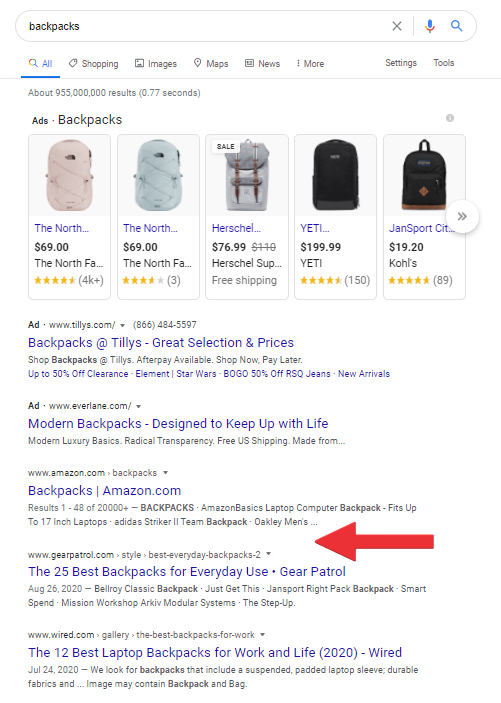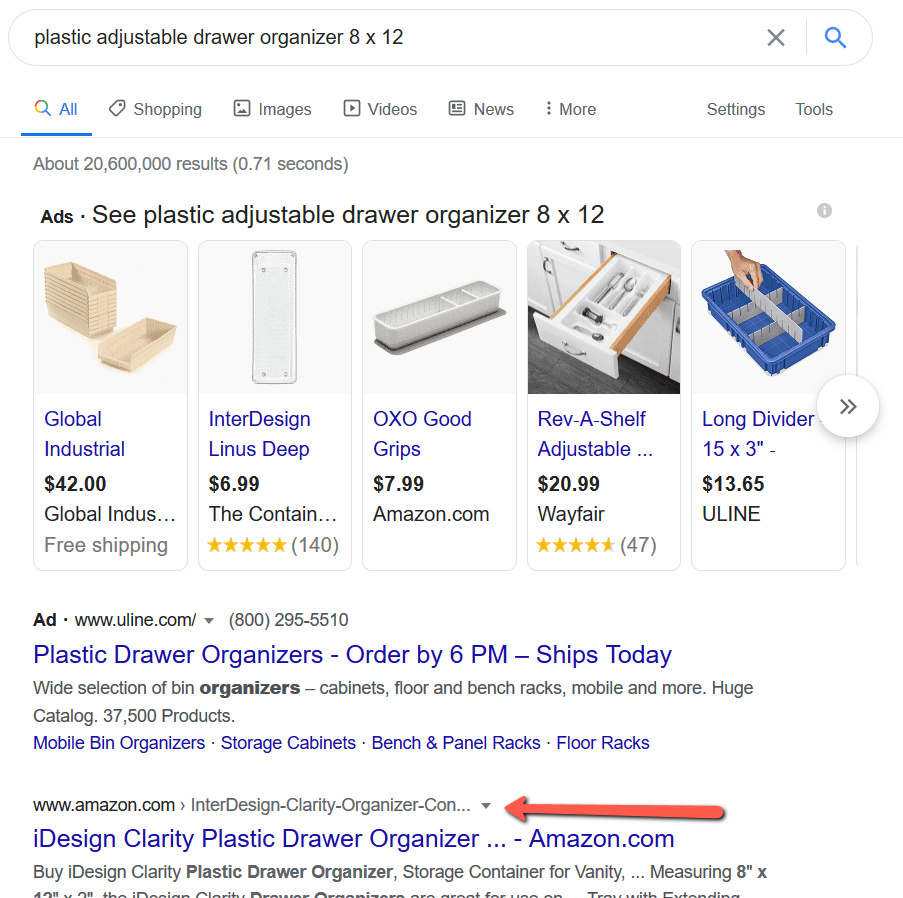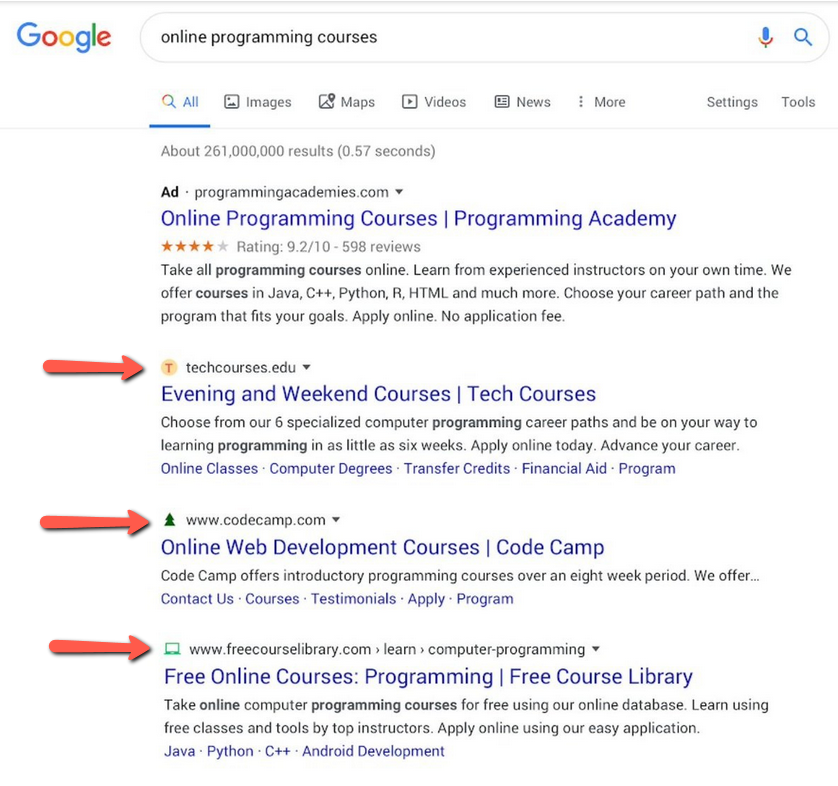
How Google Redesigns Affect Organic Search Rankings (and What to Do)
Over the years, Google has undergone many changes and made countless updates. If you’ve been using the search engine for a while, you’ve probably noticed an increase in the number of ads at the top of search results. Unfortunately, this shift in prioritizing paid ads has led to many sites losing their organic search rankings for certain keywords…
Now, we don’t want to paint Google in a bad light. Without the behemoth search engine, you wouldn’t be able to snag exposure to its 1.5 billion active users.
That said, if you’ve been feverishly working on your SEO, but your traffic never really lived up to the hype, you may be feeling more than a little frustrated.
We get it.
Fortunately, there is a solution. And it’s all about leveraging the platform wisely to get the most out of your marketing campaigns. But first, let’s talk about organic search rankings…
The Evolution of Google and Changes to Organic Search Rankings
If you weren’t already aware, Google’s mission is to “organize the world’s information and make it universally accessible and useful.” They strive to provide users with the most comprehensive search experience possible. That means displaying relevant information from non-advertising websites on search results pages. We call these organic search results, and they show up below the top advertisements.

A screenshot of a search page, minimized to show the first few organic results.
Years ago, each Google search results page displayed three to four organic results without users needing to scroll down the page to see them. These top spots on page one garnered massive traffic for the lucky ones who snagged these coveted positions.
But let’s face it… Google is a business just like any other, which means they need to make money. And one way they do that is by allowing advertisers to place ads on their search results pages.
Google has been slowly edging out organic search results in favor of paid advertisements. And now, it’s rare to see organic search results displayed above the fold (visible without users needing to scroll), especially when short and/or generic queries are used.
The search engine even tried testing what some viewed as a questionable redesign in January of this year. They added small icons next to organic results, which made them less distinguishable from ads.
However, the update was short lived as marketers called out the search engine for this supposed “sneakiness” and Google backtracked on its controversial redesign.
Here’s the undeniable truth: Google favors advertisers and will continue to optimize search results pages to bring in more money.
If you’ve experienced a loss in organic search rankings, it’s understandable that you may be feeling frustrated. But we don’t suggest you boycott Google or throw in the towel. By taking a new approach, you can still solidify a strong traffic strategy.
The Need for a New Approach to SEO
Because of the changes to Google’s search results pages, many people have started asking, “Is SEO dead?” But we don’t think so. And here’s why…
- Even though scroll-happy users are not as prevalent, many still move down past the advertisements and click on organic search results.
- While Google enjoys 92.3% of the search engine market share worldwide, sites like Bing and Yahoo can still offer marketers a decent amount of traffic.
- Google still uses a more traditional search page design for long-tail keywords. Focusing on many long-tail keywords can help you gain traffic without spending a lot on advertising.

Using SEO to increase traffic can still be worthwhile, but only when it becomes one part of a comprehensive strategy. On its own, SEO is not reliable enough to anchor the totality of business growth. When it fails, you risk falling behind if you haven’t diversified.
At any moment, Google can change the game, and you can lose everything because you have no control over its algorithm and search page design. To stay in the game, you need to adopt some new tactics to futureproof your business.
Here’s the thing: SEO (done right) focuses on improving your site and delivering high-quality, targeted content. Incorporating this type of content into your marketing strategy will always be a profit-boosting endeavor, regardless of whether you advertise. If you want to build authority and educate your target audience, creating excellent content is one of the best ways to do it.
Creating content just to rank in Google’s organic search results is not a sustainable approach, however. You need a 360-degree marketing perspective that includes a two-tier approach to search engine traffic.
A Business-Boosting, Two-Tiered Approach to Search Traffic
We’ve established that Google has shifted to more of a pay-to-play model, and the search engine isn’t giving away its prime real estate for free anymore. To play the game and reap the spoils, you need to adopt a two-tiered approach.
- Create well-optimized content that speaks to your target audience.
First, create content that solves your target’s problem and answers their questions, then optimize it for the search engines. If you have been working on this tactic as part of your SEO strategy, and creating epic content loved by your audience, you are one step ahead of the game!
The goal here is to develop high-quality, keyword-focused content that satisfies user queries better than anything already available.
Here is a typical step-by-step SEO strategy:
- Find out what your audience’s burning questions, needs, and pain points are. If you don’t know, step back and do some market research. Without this market data to support your strategy, you will waste time and money testing failure-driven tactics.
- Research keywords related to these topics. Focus on low-competition, high-volume, long-tail keywords.
- Review the existing content in Google that ranks in the top five spots for these keywords.
- Aim to create well-optimized content that provides even more value than these pieces by adding more details, examples, graphics, downloads, and whatever else will enhance the user experience.
- Publish the piece, share it on social media, and encourage others to read it.
The above is a basic overview of some steps you may take when creating content you want to achieve organic search rankings for in Google (or any other search engine). Depending on the keyword, it could take anywhere from three months to three years to rank on the first page—that is, of course, if you are SEO savvy.
- Advertise on Google with the same keywords.
While you execute your SEO content strategy, bid on the same keywords with Google ads to get your pieces in front of your targets.
In addition to getting quick traffic and exposure, this tactic also benefits your SEO strategy. Google ranking signals rely on social engagement, user time on your site, and the user’s overall experience with your content. If you are advertising the right content, your target audience will find it from your ads (quickly) and engage with it, which will show Google that your content is well liked.
By creating content optimized for your users and Google, and then bidding on the same keywords to advertise to your targets first, you give it every opportunity to gain exposure in the short and long term. This two-tiered approach fuels a 360-degree marketing strategy, which is the foundation for rock-solid businesses that are unshaken by Google changes and industry shifts.
Additional Benefits of the Two-Tiered Approach
This one-two punch of approaching keyword-focused content can also benefit you in other ways, such as giving you the opportunity to…
- Repurpose your keywords
When you run advertising campaigns and bid on keywords, you will notice that some of your keywords will be winners, and some will flop. Take notice of your winners because they’ve proven to be interesting topics to your target audience.
For example, if a winning keyword from your holiday loungewear campaign was “soft, oversized loungewear,” create additional campaigns around this topic on social media (run ads and post content about it) and in customer emails. You may also discover that one product performs better than others, which can inform future product creation.
- Test keywords first with PPC
Another way to unite SEO and PPC strategy is to test keywords with PPC ads before launching an SEO campaign. Test the conversion rates of several keywords using PPC. Use the top performers to launch your SEO campaigns instead of wasting time with keyword-focused content that may or may not convert.
The Future of Organic Search Rankings – What You Need to Know
Organic search rankings may be shifting down, but great marketers know how to adjust and futureproof their marketing to withstand unexpected blows. So, if you’re frustrated by the changes you’ve seen on Google’s search results pages, it’s time to try a different way. By adopting a two-tiered approach in which you…
- Create high-quality, well-optimized content that answers your audience’s exact questions
- Bid on the same keywords in your paid advertising
…you can bring in more traffic to your site and improve your visibility.


